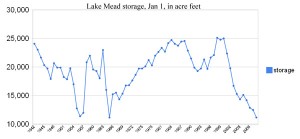As an addendum to Emily Green’s year-end look at Lake Mead (High good, low bad) I’d like to extend the analysis back a bit farther in time.
Emily points out that, while population has risen over the past decade in the region served by Mead (one of the two large storage reservoirs on the Colorado), the lake’s levels have been steadily dropping:
While federal Bureau of Reclamation records show that the elevation of Lake Mead, the major “lower basin” Colorado River reservoir serving Arizona, California and Nevada, fell more than 117 feet, the population of the US states served by Mead rose. The US Census Bureau estimates that the population of the driest state in the country, Nevada, climbed 32.3%, while Arizona’s increased 28.6% and California’s 9.1%.
In fact, you can extend that back in time. While the population in those states is the highest it has ever been, Mead, as measured by the amount of water currently in storage, is the lowest it has been since the lake was first filled:
(Data available here)
The Jan. 1, 2010 number shown above is preliminary and subject to change, but as it stands now Lake Mead appears to be starting 2010 with the less water in storage than at the start of any year since it was first filled. Previous years with similarly low levels: 1956 and ’57 (the heart of the drought of the ’50s) and 1965 (when Mead dropped because water was being held upstream to fill Lake Powell, behind the newly completed Glen Canyon Dam).


good point
Pingback: High good, low bad. Lake Mead elevations 1999-2009 | Chance of Rain